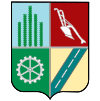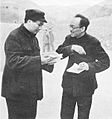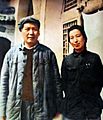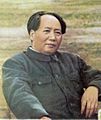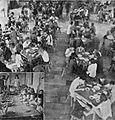Mao facts for kids
Quick facts for kids
Mao
|
||
|---|---|---|
|
Municipality
|
||
| Santa Cruz de Mao | ||
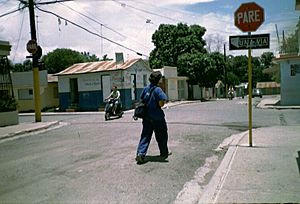
Street in Mao
|
||
|
||
| Nickname(s):
City of Beautiful Sunsets
|
||
| Country | ||
| Province | Valverde | |
| Founded | 1875 | |
| Municipality since | 1882 | |
| Municipal Districts | Ámina, Jaibón (Pueblo Nuevo), Guatapanal | |
| Area | ||
| • Total | 116.3 km2 (44.9 sq mi) | |
| • Urban | 11.51 km2 (4.44 sq mi) | |
| Elevation | 78 m (256 ft) | |
| Population
(2010)
|
||
| • Total | 51,647 | |
| • Density | 444.08/km2 (1,150.2/sq mi) | |
| • Urban | 49,714 | |
| Demonym(s) | Maeño (female, maeña) | |
| Time zone | UTC-4 (AST) | |
| • Summer (DST) | UTC-4 (AST) | |
| Distance | 60 km (37 mi) to Santiago 210 km (130 mi) to Santo Domingo |
|
Santa Cruz de Mao, often called just Mao, is a city in the Dominican Republic. It is the main city of the Valverde province, located in the northwest part of the country. Mao is the biggest city in the Dominican northwest and an important center for the region.
Contents
City Name and Nickname
The name Mao comes from the Taíno language. It is named after the Mao River, which flows close to the city. Mao is also known as Ciudad de los Bellos Atardeceres, which means "City of the Beautiful Sunsets". This nickname comes from the amazing sunsets you can see there. Since there are not many mountains to the west, the sky often turns a beautiful red color. This happens because the region is very dry, and there is a lot of dust in the air that makes the sky look red during sunset.
Population of Mao
In 2010, about 51,647 people lived in the Mao area. Out of these, 25,663 were men and 25,984 were women. Most of the people, about 49,714, lived in the city area. This means that a large part of the population lives in the urban part of Mao.
History of Mao
For a long time, the area where Mao is now was called "El Despoblado". This means "the unpopulated region" because very few people lived there. It was a very dry place, so agriculture was hard to do.
In 1606, the governor of the Spanish colony ordered everyone living on the northern coast to move inland. Some people then came to live around what is now Mao. They raised cows on large farms called hatos (ranches). This is why many places near Mao have "hato" in their names, like Hatico, Hato del Yaque, and Hato Nuevo.
The town of Mao grew up near where the Mao river meets the Yaque del Norte river. The first Catholic church was built there in 1869.
Mao became a Puesto Cantonal (an old type of local government) in 1882. Later that year, it was made a municipality. In 1904, its official name was changed to "Valverde" to honor José Desiderio Valverde, a former President of the Dominican Republic. However, people still knew the city as Mao. So, it became common to call it "Valverde (Mao)", and many people still use this name today.
In 1959, when the Valverde province was created, Mao became its main city and the capital of the province.
Geography of Mao
Mao covers a total area of about 116.3 km2 (45 sq mi). This is about 14% of the total area of the Valverde province. The city is about 78 m (256 ft) above sea level. It is located about 210 km (130 mi) northwest of Santo Domingo, the capital of the Dominican Republic.
The municipality of Mao shares borders with other areas. To the west, it borders the Santiago Rodríguez province. To the south and east, it borders the Santiago province. To the northwest, it borders the municipality of Laguna Salada, and to the northeast, it borders the municipality of Esperanza.
Mao's Climate
Mao has a tropical wet and dry climate, also known as a savanna climate. This means it has a rainy season and a noticeable dry season, especially in winter.
The city gets about 699.6 mm (27.5 in) of rainfall each year. May is usually the wettest month, with about 119.1 mm (4.7 in) of rain. October is the second wettest month.
The driest time of year is winter. January gets the least rain, with about 21.6 mm (0.9 in). July is also very dry.
Mao is a hot place. The average temperature for the whole year is about 27 °C (80.6 °F).
| Climate data for San José de Ocoa (1961–1990) | |||||||||||||
|---|---|---|---|---|---|---|---|---|---|---|---|---|---|
| Month | Jan | Feb | Mar | Apr | May | Jun | Jul | Aug | Sep | Oct | Nov | Dec | Year |
| Mean daily maximum °C (°F) | 30.2 (86.4) |
30.9 (87.6) |
32.1 (89.8) |
33.0 (91.4) |
33.7 (92.7) |
34.7 (94.5) |
35.1 (95.2) |
35.5 (95.9) |
35.2 (95.4) |
34.1 (93.4) |
31.7 (89.1) |
30.1 (86.2) |
33.0 (91.5) |
| Mean daily minimum °C (°F) | 18.7 (65.7) |
19.1 (66.4) |
19.9 (67.8) |
20.9 (69.6) |
21.9 (71.4) |
22.7 (72.9) |
23.1 (73.6) |
23.0 (73.4) |
22.5 (72.5) |
21.9 (71.4) |
20.7 (69.3) |
19.2 (66.6) |
21.1 (70.1) |
| Average rainfall mm (inches) | 21.6 (0.85) |
34.4 (1.35) |
38.5 (1.52) |
71.4 (2.81) |
119.1 (4.69) |
72.0 (2.83) |
27.3 (1.07) |
42.9 (1.69) |
75.3 (2.96) |
81.9 (3.22) |
74.9 (2.95) |
40.3 (1.59) |
699.6 (27.53) |
| Source: NOAA | |||||||||||||
| Weather chart for Mao | |||||||||||||||||||||||||||||||||||||||||||||||
|---|---|---|---|---|---|---|---|---|---|---|---|---|---|---|---|---|---|---|---|---|---|---|---|---|---|---|---|---|---|---|---|---|---|---|---|---|---|---|---|---|---|---|---|---|---|---|---|
| J | F | M | A | M | J | J | A | S | O | N | D | ||||||||||||||||||||||||||||||||||||
|
22
30
19
|
34
31
19
|
39
32
20
|
71
33
21
|
119
34
22
|
72
35
23
|
27
35
23
|
43
36
23
|
75
35
23
|
82
34
22
|
75
32
21
|
40
30
19
|
||||||||||||||||||||||||||||||||||||
| temperatures in °C precipitation totals in mm |
|||||||||||||||||||||||||||||||||||||||||||||||
|
Imperial conversion
|
|||||||||||||||||||||||||||||||||||||||||||||||
Administrative Divisions
The municipality of Mao is divided into three smaller areas called municipal districts. These districts help manage the different parts of the municipality.
| Code | Municipal district | Population (2010) |
|---|---|---|
| 270102 | Ámina | 8,270 |
| 270103 | Jaibón (Pueblo Nuevo) | 8,309 |
| 270104 | Guatapanal | 8,637 |
Economy of Mao
The main way people make a living in Mao is through agriculture. The most important crops grown in the municipality are rice, bananas, and plantain. These crops are very important for the local economy.
| Provincial capitals of the Dominican Republic | |
|---|---|
| Azua • Baní • Barahona • Bonao • Comendador • Cotuí • Dajabón • El Seibo • Hato Mayor • Higüey • Jimaní • La Romana • La Vega • Mao • Moca • Monte Cristi • Monte Plata • Nagua • Neiba • Pedernales • Puerto Plata • Sabaneta • Salcedo • Samaná • San Cristóbal • San Francisco de Macorís • San José de Ocoa • San Juan de la Maguana • San Pedro de Macorís • Santiago de los Caballeros • Santo Domingo • Santo Domingo Este | |
Images for kids
-
Mao in Yan'an
-
Zhang Guotao (left) and Mao Zedong in Yan'an, 1937
-
Mao at Joseph Stalin's 70th birthday celebration in Moscow, December 1949
-
Mao and Zhou Enlai meeting with Dalai Lama (right) and Panchen Lama (left) to celebrate Tibetan New Year, Beijing, 1955
-
Mao with Nikita Khrushchev, Ho Chi Minh and Soong Ching-ling during a state dinner in Beijing, 1959
-
Mao with Henry Kissinger and Zhou Enlai, Beijing, 1972
-
U.S. President Gerald Ford watches as Henry Kissinger shakes hands with Mao during their visit to China, December 2, 1975
-
A public appearance of Chairman Mao and Lin Biao among Red Guards, in Beijing, during the Cultural Revolution (November 1966)
-
A large portrait of Mao at Tiananmen
-
In 1978, the classroom of a kindergarten in Shanghai putting up portraits of then- Chairman Hua Guofeng and former Chairman Mao Zedong
-
Mao greets U.S. President Richard Nixon during his visit to China in 1972.
-
Mao's calligraphy: a bronze plaque of a poem by Li Bai. (Chinese: 白帝城毛澤東手書李白詩銅匾 )
See also
 In Spanish: Mao Zedong para niños
In Spanish: Mao Zedong para niños


